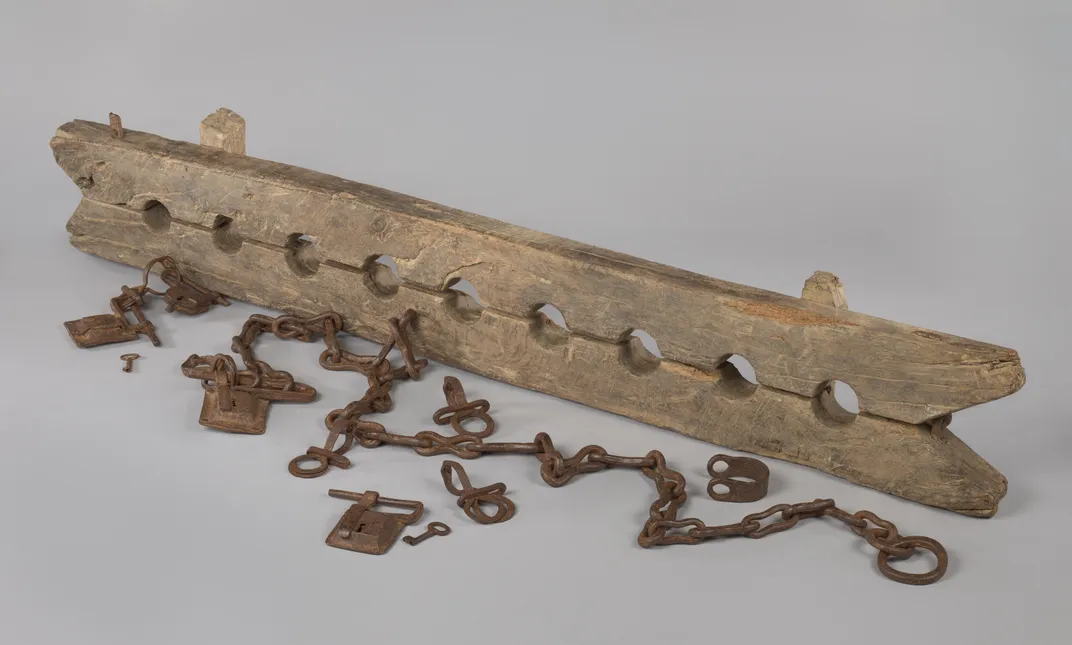Confronting the Netherlands’ Role in the Brutal History of Slavery
A Rijksmuseum exhibition explores the legacy of colonialism and misleading nature of the term “Dutch Golden Age”
:focal(524x984:525x985)/https://tf-cmsv2-smithsonianmag-media.s3.amazonaws.com/filer/60/0e/600ee2aa-2ebf-4b0e-a42c-b98cb4cd2dfb/ng-2013-22-19.jpg)
Historians studying the Netherlands’ history sometimes refer to the 17th century as the “Dutch Golden Age.” The term refers to an era of unprecedented wealth in the Dutch Republic, when artists such as Rembrandt van Rijn and Johannes Vermeer painted masterpieces and intellectual life flourished in cities like Amsterdam and Delft.
But this glittery phrase obscures a dark truth: Many of the republic’s wealthiest residents made their fortunes through the enslavement, sale and exploitation of African people. The dissonance between the “Golden Age” descriptor and this horrific reality is such that in 2019, the Amsterdam Museum announced plans to remove the term from its galleries—a major step in nationwide efforts to explain and contextualize Dutch citizens’ role in the transatlantic slave trade.
Now, a major exhibition at the Rijksmuseum in Amsterdam is examining this period in all its brutality. “Slavery,” which debuted online last month and is set to welcome in-person visitors when the museum reopens this summer, traces the global history of colonialism through the stories of ten individuals, including those who suffered enslavement and those who profited from it.
All told, reports Daniel Boffey for the Guardian, Dutch traders enslaved and forcibly transported some 600,000 African people to the Americas and between 660,000 and 1.1 million people around the Indian Ocean during the so-called “Golden Age.”
As Valika Smeulders, head of the museum’s history department, tells Mike Corder of the Associated Press (AP), organizers aimed to create a show that emphasizes how this legacy has shaped the lives of all Dutch residents—not just the descendants of the enslaved.
“We wanted to make the case, that this is a history that speaks to anybody in the Netherlands,” she says. “It belongs to all of us, so that’s why we chose a personal approach.”
Speaking with Emi Eleode of the Art Newspaper, Smeulders adds that the museum also revised the wall text for about 70 objects with previously undisclosed relationships to the slave trade.
For the exhibition, curators united more than 140 artifacts that trace the history of Dutch involvement in the slave trade between the early 1600s and 1863, when the practice was outlawed in Suriname and the Antilles, per the Guardian. (At the time, the former was a Dutch plantation colony known as Surinam; the latter refers to a group of Caribbean islands, some of which were then under Dutch control.) These include items cherished by enslaved people, such as blue sparkling glass beads that were once used as currency on the Dutch island of Sint Eustatius. Local legend holds that at the moment of emancipation, people threw these beads into the ocean in an expression of joy, reports the Art Newspaper.
Curators also included works that are rarely explicitly linked to slavery: For instance, two Rembrandt portraits in the exhibition depict wealthy elites who profited from enslavement. Another display case holds a richly decorated brass collar that researchers once thought belonged to a family dog. As it turns out, the collar was actually designed to be worn by enslaved Black people who worked in some of the Netherland’s wealthiest households, according to the Guardian.
Ten individual narratives anchor the show. One is the story of Wally, an enslaved man who was forced to work on a sugar plantation in Suriname in the early 18th century. In 1707, Wally fled captivity after arguing with his enslavers; later, he was recaptured, tortured and burned to death for attempting to escape.
An audio guide for the show includes the rarely heard oral history of Ma Chichi, a woman born into slavery in 1853. In the recording, which was made when she was 105 years old in 1958, Chichi relates her grandmothers’ experiences living as an enslaved woman in 18th-century Curaçao, notes the Guardian.
The show also features the story of Oopjen Coppit, the wealthy Dutch widow of Marten Soolmans, whose family owned the largest sugar refinery in Amsterdam. Per the AP, men and women enslaved in South America harvested the crops processed at the refinery under brutal conditions. In 1634, Oopjen sat for a portrait by Rembrandt, who rendered the material evidence of her slave-derived wealth in sharp detail: Pearls, lace, gold jewelry and other finery abound.
Though the exhibition focuses on individual narratives specific to Dutch colonial history, curators hope that its major themes resonate far and wide.
“Colonial history is international history that binds Europe, the transatlantic world and the world around the Indian Ocean together,” Smeulders tells the Art Newspaper.
“Slavery” will be on view at the Rijksmuseum in Amsterdam through August 29. Materials from the show are available to peruse online.
/https://tf-cmsv2-smithsonianmag-media.s3.amazonaws.com/accounts/headshot/nora.png)
/https://tf-cmsv2-smithsonianmag-media.s3.amazonaws.com/filer/50/3a/503a2073-903e-42c2-93c2-7f0b4cc2aa20/sk-a-4062.jpg)
/https://tf-cmsv2-smithsonianmag-media.s3.amazonaws.com/filer/02/14/02145868-427f-47bf-bbcd-913982c885ce/screen_shot_2021-06-01_at_12605_pm.png)

/https://tf-cmsv2-smithsonianmag-media.s3.amazonaws.com/filer/e5/3a/e53a6845-50f6-4649-85cd-3766c14250a3/_mg_4165.jpg)
/https://tf-cmsv2-smithsonianmag-media.s3.amazonaws.com/accounts/headshot/nora.png)